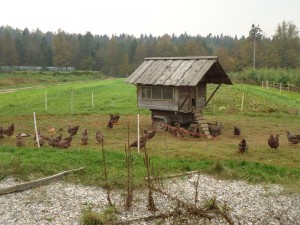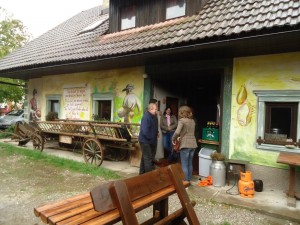
- DATE: 26.03.2013
- PROJECT NAME: Ekokmetija Pri Sustarju [Ecological Farm Shushtar]
- LOCATION: Hotemaze, Slovenia SIZE: 2 Hectares + 1500H Zone 5
- DATE DESIGNED/PLANNED: 1989 DESIGNER: Primoz Kriselj
- CLIENT/DEVELOPER: Primoz Kriselj
- MANAGED BY: Primoz Kriselj
- CONTACT AND FURTHER INFORMATION: Primoz Kriselj, primoz [dot] kriselj [at] siol [dot] net (primoz[dot]kriselj[at]siol[dot]net)
Context - Physical/social/historical Valley of the river Kokra. Glaciation valley. 420m above sea level. Continental alpine climate. The farm is situated on the edge of the village of Hotemaze. The original farm is in the centre of the village. A new farm house was built on the outskirts of the village in 2005. Originally the farm belonged to Primoz’s father and now the old farmhouse has been ‘converted’ to a living museum.
Site Analysis/Description - Place/use Originally rather poor pasture land with a thin soil on the banks of the river Kokra. A flat site exposed to the prevailing northerly winds. Poor soil and gravel. Annual rainfall 1800mm concentrated in autumn to April. Rapid draining of the soil leads to water shortage in the summer months.
Project Background and History Originally a self–sufficient farm until the end of the second world war. The farm remained unchanged since the first world war. The farm was inherited by Primoz’s father who then passed it on to Primoz in 2000.
Design, Development and Decision-Making Process In 1984 Primoz started by keeping sheep (a legal requirement to have livestock in order to have ownership of land in former Yugoslavia). They started worm composting project using mushroom growing waste and animal manure. Market for compost declined so they started growing vegetables to give added value to the compost being produced. In the late 1980’s Graham Bell ran a PDC in Slovenia which Primoz attended. They invited Graham Bell to visit the farm and he found it a very nice permaculture farm.They ran a PDC on the farm with Peter Birkett; the design project was the farm. They got planning permission to build new farmhouse. It is a family farm, so decisions are made by the family.
Role of Designer(s) Input from permaculture teachers. Otherwise gradual evolution of the current design.
Programme Elements – what was planned/ the site functions (use, users, activity) Vegetable production. Livestock that includes ducks, chickens and other poultry. Sheep (200) which bring a subsidy yield and also build the fertility (manure) plus meat and wool. About forty pigs. Education centre for children and adults.
Maintenance and Management – long and short-term view Some seasonal local labour is bought in. Some students also, for work experience. They are planning to offer Wwoofing opportunities. Otherwise, the site is managed and maintained by Primoz and his partner, Polonca.
User/Use Analysis Food production. The harvest is sold through organic markets in Slovenia and Austria and to quality restaurants. Also sausages and ham is produced and sold to customers in London and Italy. They are developing a CSA starting with a box scheme using a local distribution point. There is also a farm shop with local clients.
Project Significance and Impact/Lessons Learned This is a real example of a financially viable farm, as well as of fertility building of poor soils using livestock and compost production. The whole family is off one hectare with diverse management and production. Successful outdoor cultivation of crops like watermelons tomatoes, peppers, aubergines etc., in an alpine climatic zone.
What could have been done differently? Could have stayed in a well-paid job – not really!
Limitations Only one hectare of land and difficult to rent or buy land locally – however this hectare is enough to support the family. Makes rotation of crops difficult.
Transferable Features and Lessons Need to be flexible and respond to market changes that influence financial viability of undertakings on the farm. Diverse activities also maintains the interest.
Future Issues/Plans To make management of the system more sophisticated. Work less to free up time to be able to do more teaching.
Does your project offer opportunities for volunteering or internships? Yes
Does the project welcome visitors or study tours? Yes
Can you offer accommodation to visitors or study tours [at the project or locally]? Yes
Web Sites/Links www.ekosustar.si
EPT participants feedback on the venue
Learnt:
- Connect tradition with permaculture
- Using local resources
- Old house
- Diversity of operations
- Value added
- The ancient tools and beautiful decoration of the house (ceramic stove, all traditional elements, very inspiring
- The garden: permaculture has no boundaries
- Hub of networking
- Productive (food)
- Financially sustainable
- Value of a family farming village
- How to make a living in contemporary society that honours “old school” ways
- People really appreciate the tradition in the place
- How you can get people’s attention more clearly, faster, using this nice example of permaculture in Slovenia
- Good food
- Successful market-farm – permaculture in practice
- World’s biggest herb spiral
- Pond lining technique
- Interesting open chimney (‘black kitchen’) serving different functions
Could Improve:
- New entrance, more attractive
- More trees
- More feng shui
- Involve neighbours
- Design more free time for owner
- On the land: more trees, more design
- Needs people and organization
- Set limits to the number of people present in that house for courses, to use the space more effectively
- Farm: potentially develop an internship programme, so that more people can learn from this model
- Make a design to include quality people to help with the farm
- Zones and sectors not clear
- Improve communication of the site design (eg, an infoboard )
- Less plastic mulch on the fields
- Log in to post comments


